Everybody experiences the world around them in different ways. Sometimes how your brain understands information from your senses can make it difficult to join in with every day activities.
This page contains resources to help you understand sensory processing and how you can support your child or young person. You can choose the resources that are right for you. There are videos you can watch, video scripts you can download and read (you can translate these or use a screen reader if you need to) and sensory questionnaires you can complete. There are also downloadable booklets, videos and information you can explore.
We want to make sure that we are giving information in the way you learn best so that it makes sense and you can use it at home. We know there is a lot of information to take in.
This workshop is for parents/carers of children/young people who have sensory processing differences. The workshop is suitable for people with no previous knowledge of sensory processing. You will learn more about what sensory processing is, the eight different senses and changes you can make to the environment to support your child/young person. The information presented in the session is the same as the videos above.
This session is only available to families of children and young people who live in the NHS Greater Glasgow and Clyde area.
Before registering please answer the following questions:
If you have answered 'yes' to all of these questions then you can register by clicking on the tabs to choose the date that suits you.
If you answered 'no' to any of the questions you can watch the videos above. If you live in NHS Greater Glasgow and Clyde you can also phone the Occupational Therapy Advice Line if you have any questions.
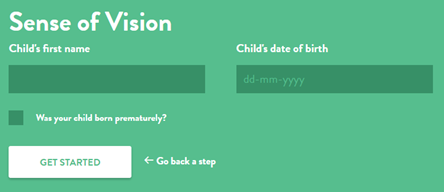
Information on each sensory system is available in 3 different age ranges. Complete the questionnaire most appropriate for your child or young persons’ developmental level. For example, if your 6 year old has an intellectual disability and is functioning at age 2 years, the strategies in the 2-5 year old questionnaire will be more helpful.
Our eyes take in information from the world which then goes to the brain. This is not the same as how well we see. If you have concerns about your child's ability to see things properly please take them to an optician for an eye test. Some people might become overwhelmed by visual information. They might find lights too bright or a room too distracting to work. They might have to close or cover their eyes. Other people might not notice things in the environment. They might seek out visual input like shiny, spinning toys or stare at things intensely.
If you think your child or young person processes visual information differently you can:

Our auditory system is our sense of hearing. We take information in from our ears. Some children might become overwhelmed or upset by lots of noise. This is common and part of normal development, but some people can remain sensitive to noise. This can stop them taking part in activities. Some people might seek out noise. They might listen to music or watch the TV with the volume turned up. Listening to the world around us helps us make sense of where we are.
If you think your child or young person processes sound differently you can:

Our touch system picks up information about our environment from sensors in our skin. These give us information about differences in things we touch. Some people can be very sensitive to touch. They might dislike certain textures or labels and seams inside clothing. Other people might not notice touch. They don't notice when their shoes are two sizes too small or may feel pain differently.
If you think your child or young person feels touch differently you can:

Our senses of smell and taste are closely linked, as they follow the same pathway through the brain. Some people might become upset by smells that no one else can smell. Other people might seek out smells and smell objects or people. Processing smell differently can make us refuse to eat different food. We all have definite sensory preferences about tastes we like or dislike. Some people might only eat bland food and find it difficult to eat different foods so have a limited diet. Other people might choose to eat intense flavours like spicy or sour foods. They might lick objects which are not food.
If you feel your child or young person processes taste or smell differently you can:

Proprioception is the awareness of body position and movement or knowing where your body is in space. Proprioceptive receptors are in the muscles and joints. They send messages to the brain to tell it where your body parts are in space. They tell you how much force or pressure your muscles are using. This helps us to know which position our body is in. Some people might bump or crash into things or hold their pencil too tightly. They might be too rough when playing with friends or chew on objects like clothing or ends of pencils.
If you feel your child or young person processes proprioceptive information differently you can:
The vestibular system gives us information about balance and movement. When your head and body move, fluid in your inner ear moves too. This gives your brain information about how you are moving. Some people process vestibular information differently. They might spin or move more than other people. Other people might avoid lots of movement. They might not like it when their feet leave the ground.
If you think your child or young person processes balance and movement information differently you can:
Sense of how the body is feeling
Interoception is the sensory system which gives us information about the internal sensations in the body and how they link with emotions. It helps us work out how the body is feeling.
The receptors for this system are throughout the body in organs like the heart, lungs, stomach, bladder and skin. They pick up information and send it to the brain where it is translated into feelings relating to body comfort like hunger, needing the toilet, sleep, being too hot/too cold. It also helps us feel our emotions.
If you process this information differently you might:
 Not know when you are full or when you are hungry/thirsty
Not know when you are full or when you are hungry/thirstyIf you have difficulty understanding these signals it could be because of how you process interoceptive input. There are however lots of different reasons why you might have difficulty understanding these signals. If you have any concerns about other possible causes please speak to your GP or Health Visitor.
What you can do:
There are still lots of discussion about what helps improve interoception. There is no good evidence that any particular strategy is effective. There is some evidence that mindfulness can help. It is important to rule out any possible underlying medical causes for the issues first if you are concerned.
Things which may help:
For example:
Help them make the connection so that the next time they have that feeling they are more confident in knowing what it means.
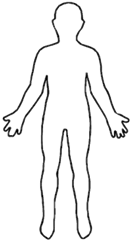
Draw an outline of a body and identify words that might go with that body part. Help your child work out what words they associate with sensations- remember they might not be the same ones you would use!
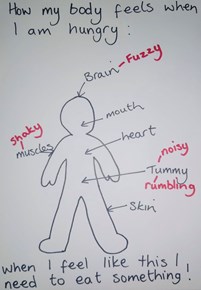 How my body feels when it is hungry
How my body feels when it is hungry
Notice: my brain feels fuzzy, my muscles feel shaky and my tummy is rumbling.
Connect: I usually notice these feelings together when I’m hungry.
Regulate: I’ll eat something.
Outcome: I notice the fuzzy head, shaky muscles and rumbling tummy have gone. I was right! I must have been hungry.
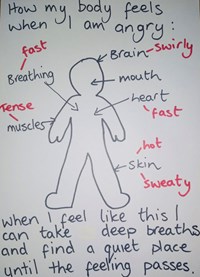 How my body feels when it is angry
How my body feels when it is angry
Notice: my brain feels swirly, my muscles feel tense, my heart is beating fast and my breathing is fast. My skin is hot and sweaty.
Connect: I usually notice these feelings together when I’m angry.
Regulate: I know this feeling will pass. I won’t feel like this forever. I will try deep breathing and finding a quiet space. This usually helps me.
Outcome: I notice the feelings are gone.
For younger children:
Listening to my Body by Gabi Garcia
Sometimes children and young people can find it difficult to take part in eating. This can be for lots of reasons. There are some things you can try at home which might help.
Have a look at our resources to find out how you can help your child to take part in eating at home.
If you think your child or young person has difficulty with eating because they process sensory information differently then you can
You know your child best and will already know lots about their likes and dislikes. Remember, understanding how your child processes sensory information is important. Changes to the environment can help your child or young person to take part in activities.
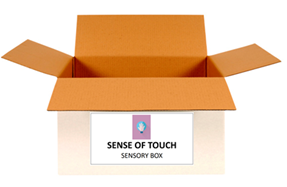 Children need lots of different sensory input for their sensory systems to develop. That is why it is so important for them to have as many different play opportunities as possible. This includes rough and tumble, messy play or exploring toys and objects. Play is important. Children may choose time in front of a computer/game console or TV screen. We need to balance this with opportunities for play to develop and learn.
Children need lots of different sensory input for their sensory systems to develop. That is why it is so important for them to have as many different play opportunities as possible. This includes rough and tumble, messy play or exploring toys and objects. Play is important. Children may choose time in front of a computer/game console or TV screen. We need to balance this with opportunities for play to develop and learn.
Our sensory system works throughout the day to keep our system balanced. We need different amounts of input to feel comfortable or ready to learn. We use our different sensory likes and dislikes to help keep our system balanced. This allows us to feel ‘just right’ for taking part in the activity we are doing. We call this sensory self regulation. Some children need more input from one or more sensory systems to self regulate. It can be helpful to pull together a collection of toys and materials for them. This means they are easy to find when they need them. These resources are known as 'Sensory Boxes'.
These leaflets provide some suggestions for ideas to keep in your sensory boxes. This is by no means an exhaustive list but provides you with some ideas to get started.


 Falkirk Council Children with Disabilities Team have published a number of booklets providing lots of useful information and ideas for supporting your child's sensory behaviours.
Falkirk Council Children with Disabilities Team have published a number of booklets providing lots of useful information and ideas for supporting your child's sensory behaviours.
Different strategies work for different people. It is important to work together with your child to try out different strategies. Please don’t expect big changes overnight. It can take several months for sensory strategies to be used effectively. Try to use the strategies you think work best for you and your child consistently for 3 months. If you still need help or advice after this time and you live in the Greater Glasgow and Clyde area you can contact the Occupational Therapy Advice Line.
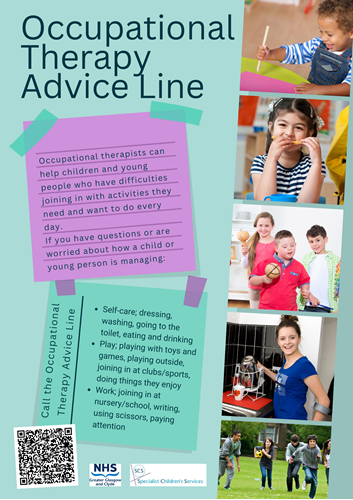 Specialist Children Services (SCS) Community Occupational Therapy Team have an advice line where parents/carers, education staff, social care staff, voluntary organisations or other health professionals can seek advice and support for children and young people who are having difficulty joining in with the activities that they need and want to do every day.
Specialist Children Services (SCS) Community Occupational Therapy Team have an advice line where parents/carers, education staff, social care staff, voluntary organisations or other health professionals can seek advice and support for children and young people who are having difficulty joining in with the activities that they need and want to do every day.
Areas that we can help with include:
Call 0141 531 6536 on
Tuesdays 1:30pm - 4:00pm
Fridays 9:30am - 12:00pm
or email ggc.scsoccupationaltherapy@ggc.scot.nhs.uk
Call 0141 314 4624 on
Thursdays 9:30am - 12 noon